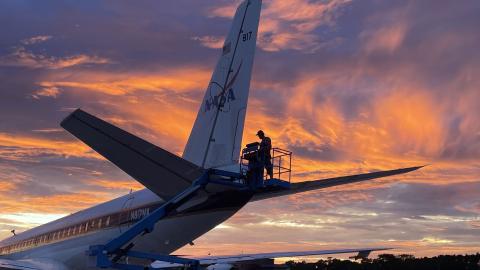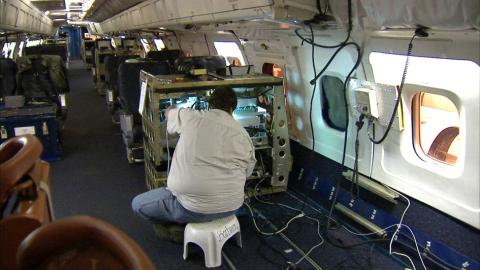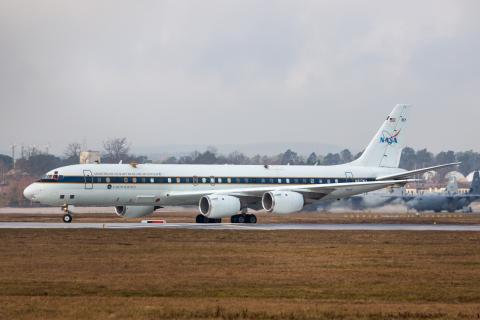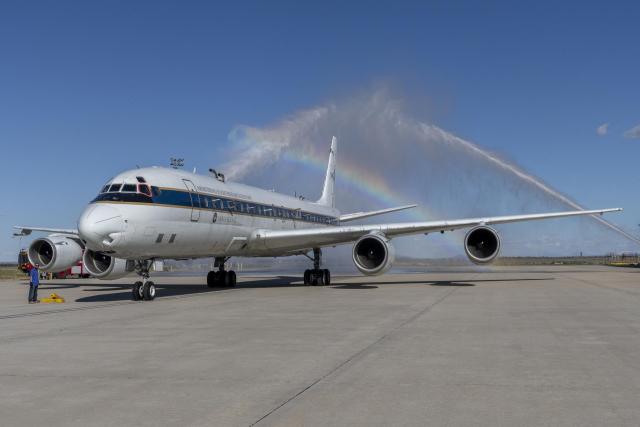After flying more than three decades and 158 science campaigns, NASA’s DC-8 Airborne Science Laboratory made its final flight on 15 May, from Edwards AFB (CA) to Idaho State University in Pocatello (ID), where it will be used to train future aircraft technicians by providing real-world experience in the college’s Aircraft Maintenance Technology Program. The journey included flybys at NASA Armstrong Flight Research Center at Edwards AFB and at the NASA Ames Research Center near San Jose (CA).
“The DC-8 flew missions all over the world,” said Michael Thomson, chief of the Science Projects Branch at NASA Armstrong. “The work we did on that aircraft will make a difference to future generations in improved weather forecasting, monitoring glacial ice thickness, air quality, and improving our ability to predict the development of hurricanes from tropical storms.”
Brockett, a retired NASA DC-8 pilot who flew the aircraft for 28 years, recalled his 2009 flight to Antarctica as his most exciting. “The science instrumentation required that we fly from 500 feet to 1,000 feet altitude. It required total focus for the 6 or 7 hours at low altitude to successfully complete a mission. The scenery was spectacular, and every mission was immensely satisfying to me. We were low enough that we occasionally got glimpses of seals lounging on the ice! I also enjoyed having a personal audience with people who were at the top of their field and were doing cutting-edge research. I was fascinated by that and helping them to go where they wanted to go.” 
The DC-8 of NASA (National Aeronautics and Space Administration) has been in service for 37 years and could carry 45 crew and passengers on a mission. It returned to NASA’s Armstrong Flight Research Center Building 703 in Palmdale (CA) on 1 April 2024, after completing its final mission supporting Airborne and Satellite Investigation of Asian Air Quality (ASIA-AQ). A busy schedule followed with removing all of its equipment, an Open Day for employees, some test flights before its last flight to Pocatello.
Originally delivered as a DC-8-62 variant to former Italian flag-carrier Alitalia in 1969 as I-DIWK (46082), the aircraft later served with Braniff International (as N801BN), who withdrew it from service in May 1982. It received CFM56-2s with the Quiet Nacelle Corporation and converted to DC-8-72 standard in 1986, when it was delivered to NASA, as N801BN. In August of that same year NASA registered the Eight as N717NA. In June 1995 it received N817NA and was operated by the University of North Dakota since 2005. While operating for them it was reregistered to N436NA in January 2006, before going back to N817NA, in November 2007, when it was returned to NASA.
In NASA service as the Airborne Science Laboratory, the DC-8 was mainly used for four major mission types: sensor development; satellite sensor verification; space vehicle launch or re-entry telemetry data retrieval and optical tracking; and research studies of Earth’s surface and atmosphere.
In 2018 the DC-8 paid a visit to Germany, in order to continue research into what happens with engine performance, emissions and contrail formation when you use different types of fuels in jet engines. It collaborated with the German Aerospace Center (DLR)’s Advanced Technology Research Aircraft (ATRA) A320 which would burn alternative biofuels, while NASA’s fully instrumented “Flying Laboratory” would trail a safe distance behind, sampling and analysing gases and particles within the ATRA’s wake. For this the DC-8 and A320 were flying missions out of Ramstein AFB, southwest of Frankfurt, which in turn led to many aviation enthousiasts paying a visit and to photograph this unique aircraft. 
Credits: NASA, Aviation Week


